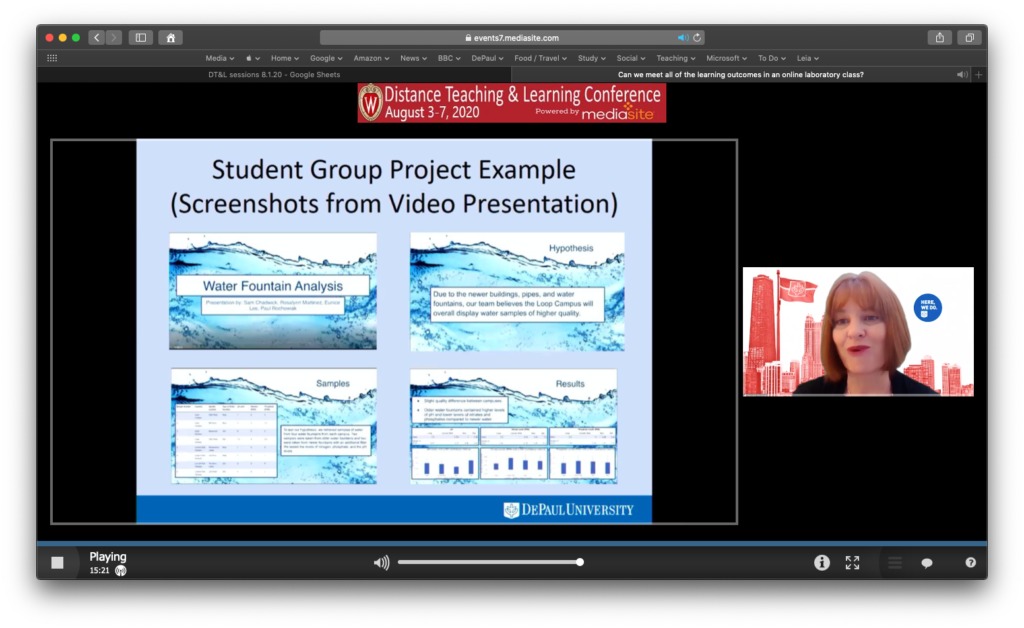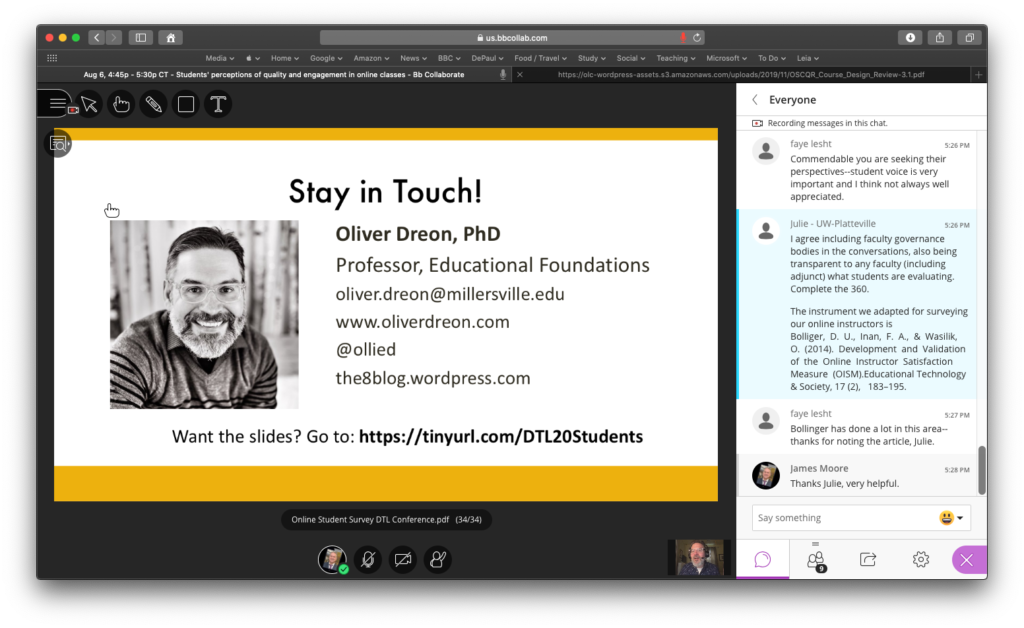
For the first time ever, the Distance Teaching and Learning conference went fully online. This is my online diary, and placeholder for things I need to return to in the future.
I must admit that I missed being in Madison this time of the year but found the online conference to be considerably more efficient. This efficiency did have a downside – I admit to being in a state of continuous partial attention as I fielded work calls and requests simultaneously.
Surprising, Slack became a vibrant and well used part of the conference. Participation in Twitter significantly declined, with far fewer #UWdtl posts, live tweeting, and side conversations this year. Slack was the place to be. Messy, information overload, and chaotic. But also humanizing, filling a gap for those started of physical interaction.
Interaction in the sessions via services like Poll Everywhere, Google Docs, and Google Slides was variable, but paid huge dividends when it worked. My advice to presenters in the future is:
- Use an easy-to-type shortened URL (bitly) and have this on all sides during the interactive parts of the presentation.
- Make sure to activate your tool of choice before the presentation starts.
- Consider placing a link in the Guidebook App.
I got to moderate some of the sessions on Tuesday and Wednesday, which gave me a glance behind the curtain. The majority of presentations used Zoom as the backend, with moderators and presenters in a Zoom breakout room. Video footage (speaker video and shared screen) was passed to Mediasite for participants to watch. Participants could type questions via Mediasite’s Q&A speech bubble, to be relayed to the humble moderator and then read out to the presenter. The tech team behind all this were exemplary – fielding issues and questions with quiet grace and authority. The more interactive sessions used Blackboard Collaborate, and here all could talk and chat simultaneously.
The majority of sessions were recorded, and these recording made available a few weeks after the conference finished. Making these recordings available is something I particularly appreciate, but it does not look as if many have taken advantage of this – the views for many sessions are in single figures at present (one session that I missed, but want to watch is “Measuring Engaged Learning in Online and Blended Courses”).
There were a few themes that seemed to bubble-up during the conference:
- Understanding how to show caring for online students
- HyFlex
- Accessibility
- Online engagement
Tuesday

My colleague Margaret Workman presented a great eposter (Can we meet all of the learning outcomes in an online laboratory class) in the morning. The eposters were the perfect format – three 15-minute sessions were repeated over 45 minutes. This meant that you could jump from eposter to eposter like a series of speed sessions. In the virtual environment, this worked very well indeed. I followed Margaret’s session with Steve VandenAvond’s eposter (Creating Your Own Reality: The development of In-House Interactive VR).
Newton Miller gave a barnstorming keynote that really kicked things up and set a tone that continued throughout the conference. Historically, the conference has been very white. Black and brown faces are not as representative at the conference, and this is not a good thing, particularly this year. Newton’s keynote and Q&A posed a series of considerations that are both timely and important.
Thomas Royce Wilson was well-prepared for his “Cranky Colleagues v. Killer Robots: Helping Others Embrace Technology” which provided a useful framework for effectively collaborating with colleagues who might be technology-averse.
Each day ended with a “live wrap up.” This helped to reinforce the sense of community and a cohesive set of programming. The wrap up was also used to share pictures from the daily hashtag competitions.
Wednesday
HyFlex was a significant theme at the conference. Brandon Taylor, Janyce Agruss, and Amy Haeger shared their experience of teaching in the HyFlex modality (360-Degree View: Shared Experiences of a HyFlex Course Design Pilot) – a modality that now seems to be featuring heavily in the pans of most colleges and universities.
Mary Ellen Dello Stritto presented on “Using Course-level Data for Research” and shared Oregon State University’s “Online Learning Efficacy Research Database.” The database is a “searchable resource of academic studies on the learning outcomes of online and/or hybrid education in comparison to face-to-face environments.” I will definitely be taking a look at this later.
Maria Widmer and Claire Barrett presented on “Strategies for Connection and Belonging in Online First-Year Seminars,” in which I was reminded of the usefulness of “jigsaw discussions.”
Jean Mandernach’s presentation on “Teach More Students Without Increasing Your Instructional Time” was particularly interesting, and something I plan to dig deeper into. She also recommended a book that looks like it could add some value (Attention Management: How to Create Success and Gain Productivity – Every Day).
Thursday
Constance Wanstreet presented on “Learning Analytics and Gateway Courses: Keys to Student Success.” I think there is a gap here that the conference could fill by offering a beginner’s guide to learning analytics, with separate audiences for educators and administrators.
Trey Martindale’s “Online Learning and the Next Few Years in Higher Education: Follow the Money” was the highlight of the day. Not the happiest of analysis but argued well and definitely of value.
Tanya Joosten presented on “Empirical Approach to Identifying Digital Learning Innovation Trends.” Those trends are helpfully contained here, with more Information on the DETA site.

Oliver Dreon ran an engaging discussion (in Blackboard Collaborate) on “Researching online students’ perceptions.” I don’t know if this is a trend, but some institutions are moving away from using the QM rubric (which has a cost) to the (free) OSCQR (SUNY Online Course Quality Review Rubric). One thing I plan to investigate later came is this discussion
The instrument we adapted for surveying our online instructors is Bolliger, D. U., Inan, F. A., & Wasilik, O. (2014). Development and Validation of the Online Instructor Satisfaction Measure (OISM).Educational Technology & Society, 17 (2), 183–195.
Overview
The conference was surprisingly emotional – the feedback that I saw shared highlighted the sense of connectedness this year. Many attendees found the virtual format to be more efficient and productive. I don’t know how much of this structure will be used in future conferences, but I see the future as being more blended.